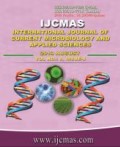


 National Academy of Agricultural Sciences (NAAS)
National Academy of Agricultural Sciences (NAAS)

|
PRINT ISSN : 2319-7692
Online ISSN : 2319-7706 Issues : 12 per year Publisher : Excellent Publishers Email : editorijcmas@gmail.com / submit@ijcmas.com Editor-in-chief: Dr.M.Prakash Index Copernicus ICV 2018: 95.39 NAAS RATING 2020: 5.38 |
Onion is one of the important and commercial vegetable crops of India. Onion is sulphur loving crop and its requirement is high for improved yield and quality. Sulphur has been recognized as an important nutrient for higher yield, quality and nutrient uptake of onion bulbs. Keeping these in view, a field experiment was conducted at ICAR- National Institute on Abiotic Stress Management (ICAR – NIASM), Baramati, during Rabi, 2017-18 to study the effect of sources and levels of sulphur on bulb quality and grading in onion (cv. Bhima Kiran). The treatments consisted of three sources of sulphur (Elemental sulphur- Bentonite clay, Potassium schoenite and ammonium sulphate) and four levels of sulphur viz., 0, 30, 45 and 60 kg S ha-1 by adopting RBD with three replications. The results on phenol, flavonoide, ascorbic acid, pyruvic acid, total soluble solids (TSS %) and grading of onion bulb viz., of A, B, C % revealed significance variations among the levels of sulphur in onion. Maximum phenol content was registered @ 45 kg S ha-1 as elemental sulphur + thiobacillus by soil application. There was equal behaviour of three rates of application of sulphur viz., 30, 45 and 60 kg S ha-1 through three sources in relation to flavonoid content. Sulphur fertilization significantly increased the ascorbic acid content of onion when applied through potassium schoenite, elemental sulphur and ammonium sulphate. Maximum ascorbic acid content of 4.69 mg g-1 was noted @ 60 kg S ha-1 through potassium schoenite by soil application. The production of pyruvic acid content in onion was enhanced significantly owing to sulphur fertilization. Maximum total soluble solids to the tune of 12.93% were noticed @ 45 kg S ha-1 as elemental sulphur + thiobacillus by soil application (45 and 60 kg S ha-1). The grading of onion is judged by grading of the bulbs significantly higher percentage of ‘A’ grade onion bulbs were obtained by 45 kg S ha-1 through potassium schoenite through nutripellet pack noted (95.2%).
 |
 |
 |
 |
 |